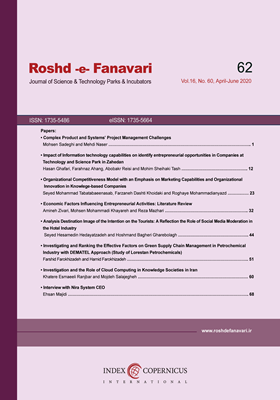Investigation and the Role of Cloud Computing in Knowledge-based Companies in Iran
Subject Areas : Science and Technology Parks and Incubatorskhatereh Esmaeeli ranjbar 1 , Mozhdeh Salajegheh 2
1 -
2 -
Keywords: Cloud Computing Iran Knowledge-based Companies Factors Adoption Ranking,
Abstract :
Cloud computing has emerged as one of the most important discussed topics among Enterprise Information Technology (IT) professionals. Small and medium enterprises with low budget and limited human resources are one of the major groups that tend to use cloud computing for achieving the benefit of this technology. A multitude of factors influence the adoption of cloud computing in Knowledge-based companies. These decisive factors must be systematically evaluated before making the decision to adopt cloud-based solutions. The purpose of this study is to identify these factors and Ranking them and determine the extent to which they influence the adoption of cloud computing for Knowledge-based companies . Therefore, the project describes a research model that is based on the diffusion of innovation (DOI) theory and the technology, organization and environment (TOE) framework. Based on previous study, research model was developed to test Twelve (12) variables. Data was collected by survey questionnaires from a sample of 59 Small and medium enterprises that all of these enterprises were in The Knowledge-based companies. 59 experts and decision makers in information technology department from those Small and medium enterprises were selected to fill the questionnaires. The research methodology was descriptive- survey and SPSS software version 23, Minitab EDI 17 and EXCEL EDI 2013 were used for data analysis. In summary, the results of this research have shown that the innovation of IT decision makers and information intensity have significant influence on adoption of knowledge-based companies with cloud computing.
1- ذبیحی، حامد، بوژآبادی، عبداله، پردازش ابری. پروژه کارشناسی. دانشکده فنی و مهندسی، دانشگاه پیامنور سبزوار. 1391.
2- فتحیکیادهی، الیاس، امکانسنجی پیادهسازی رایانش ابری در سازمانها و صنایع ایران: فرصتها، تهدیدات. پایاننامه کارشناسیارشد. دانشکده مهندسی صنایع. دنشگاه صنعتی خواجه نصیرالدین طوسی. 1392.
3- عباسی، زهره، آبام. زویا، مدیریت و اشتراک دانش مبتنی بر رایانش ابری در کتابخانهها و مراکز اطلاعرسانی. همایش ملی مدیریت دانش: حال و آینده، 1392.
4- http://www.persianpersia.com/tech/tdetails.php?articleid=20442&parentid=49&catid=148. رایانش ابری یا همان cloud computing به زبان ساده چیست؟ [تاریخ دسترسی: 1394]
5- اقبالی، محمد. امکانسنجی استقرار فناوری رایانش ابری در دانشگاههای دولتی ایران ـ مطالعه موردی: دانشگاه سیستان و بلوچستان. پایاننامه کارشناسیارشد. دانشکده مدیریت فناوری اطلاعات. دانشگاه سیستان و بلوچستان، 1392.
6- صفری، فریبا، ارائه مدل پذیرش رایانش ابری در شرکتهای کوچک و متوسط صنعت IT. پایاننامه کارشناسیارشد. دانشکده مدیریت و اقتصاد. دانشگاه تربیت مدرس، 1392.
7- ختن لو، حسن، طراحی و پیادهسازی مرکز رایانش ابر خصوصی. طرح پژوهشی، 1392.
8- بنگشی، آزاده، محافظت و ایمنسازی سیستمهای ابری در برابر حملات. پایاننامه کارشناسیارشد. دانشکده برق و کامپیوتر. دانشگاه آزاد اسلامی واحد شاهرود، 1394.
9- اژدری، گلناز، لگزیان، محمد، شیرازی، علی، فیاضی، مرجان، الگوی بومی شاخصهای مؤثر در بهکارگیری خدمات مدیریت منابع انسانی الکترونیک مبتنی بر رایانش ابری در شرکتهای دانشبنیان. پژوهشنامه پردازش و مدیریت اطلاعات دانشگاه فردوسی مشهد. دوره 34 شماره 2، 1394.
10- قهرمانی، تورج، شایان، علی. شناسایی و اولویتبندی عوامل مؤثر بر موفقیت رایانش ابری در صنعت بانکداری: مورد مطالعه بانک ملی ایران. علوم رایانشی، تابستان 1397.
11- کربلایی آقاسی، آرش، سرهنگی، کامران، حاجیلو، امید. بررسی تأثیر رایانش ابری بر عملکرد سازمانی شرکتهای بازرگانی و تجاری، اولین کنفرانس علمی پژوهشی دستاوردهای نوین درمطالعات علوم مدیریت، حسابداری و اقتصاد ایران، ایلام، 1397.
12- ترابیگلسفید، یوسف. بررسی نقش امنیت بهعنوان مهمترین چالش در بکارگیری رایانش ابری در سازمانها. دو فصلنامه مهندسی شناورهای تندرو. شماره 48. بهار و تابستان 1395.
13- محاسبه آنلاین فرمول کوکران برای حجم نمونه. آدرس: http://www.banarvan.com/Content /
14- Garison, G., wakefield, R. l., kim, s. The effects of IT capibilites and delivery model on cloud computing success and firm performance for cloud supported processes and operations, International journal of information management. (34)4, 377-393, 2015.
15- Motahari Nezhad, HR, Stephenson, B, Singhal, S. Outsourcing Business to Cloud Computing Services: Opportunities and Challenges. IEEE Internet Computing Palo Alto. 10, 2009.
16- Khajeh-Hosseini, A., Greenwood, D., & Sommerville, I. Cloud migration: A case study of migrating an enterprise it system to iaas. In Cloud Computing (CLOUD), IEEE 3rd International Conference on. 450-457. IEEE. 2010.
17- Low, C., Chen, Y., & Wu, M, Understanding the determinants of cloud computing adoption. Industrial management & data systems, 111 (7), 1006-1023, 2011.
18- Khajeh Hosseini, A, Greenwood, D, Smith, JW, Sommerville, I, The cloud adoption toolkit: supporting, cloud adoption decisions in the enterprise. Software: Practice and Experience, 42(4), 447-465, 2012.
19- Alshamaila, Y., Papagiannidis, S., & Li, F. Cloud computing adoption by SMEs in the north east of England: A multi-perspective framework. Journal of Enterprise Information Management, 26(3), 250-275, 2013.
20- Ramezani, S. Factors Influencing the Adoption of Cloud Computing by Small and Medium- Sized Enterprises (SMEs). Master Thesis, Ryerson University, 2013.
21- Amini, M, The factors Influence on adoption of Cloud community for small and medium Enterprises. Master of Science, Faculty of computing university Teknologi Malaysia, 2014.


